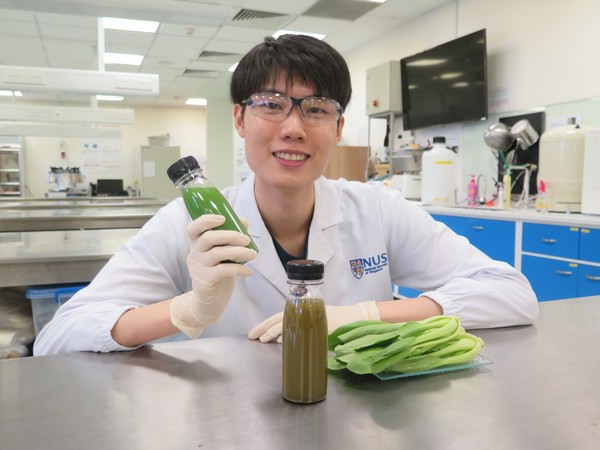Enjoying a glass of juice, tucking into a hearty piece of meat or having a plate of cut fruit may be part of the diet that many do not give much thought to. However, could these common food items be more nutritious or sustainable? Some final-year undergraduate students at NUS Food Science and Technology (FST) are applying their knowledge and creativity to address these needs.

Cold pasteurised juices are gaining popularity, but most juices in the market are more commonly preserved by thermal pasteurisation. Chew Ding Xiang’s final-year project examines the effect of High-Pressure Processing (HPP), which is an industrial non-thermal process involving the application of high pressure to inactivate microorganisms in food, on the nutrient preservation of vegetable juice.
“Vegetable juices are popular as a low-sugar alternative to fruit juices and for their reputation as ‘detox drinks’,” said Ding Xiang, as he explained the context of his project.
 Bok choy juice that has been high-pressure processed retains nutrients and freshness well
Bok choy juice that has been high-pressure processed retains nutrients and freshness well
Based on his research, Ding Xiang found that the bok choy juice he prepared using HPP not only preserved nutrients well, it also retained the ideal sensorial properties of the juice. The colour of the juice was a fresh-looking green, compared to the dark, less appealing green of the thermally processed version.
“This means that HPP could be a viable option to produce and distribute vegetable juices on a large scale, and consumers can enjoy greater convenience and accessibility. Furthermore, as vegetables are susceptible to spoilage, juicing is one way to help reduce wastage,” said Ding Xiang.
Compared to whole fruits, cut fruits usually lose their nutritional quality and moisture faster over time. To improve the shelf life and add to the nutritional quality of cut fruits, FST student Ian Mak developed an edible probiotic coating. His research involved dipping apple slices into the probiotic coating solution he developed and then testing for shelf-life characteristics.
With the probiotic coating, Ian observed a reduction in the growth of spoilage microorganisms such as mould, and rate of moisture loss which allowed the apples to remain fresh and retain their texture. He also found that adding the coating could allow cut apple slices to last two to three days longer than those without.
For more information:
National University of Singapore
21 Lower Kent Ridge Road
Singapore 119077
Tel.: +65 6516 6666
